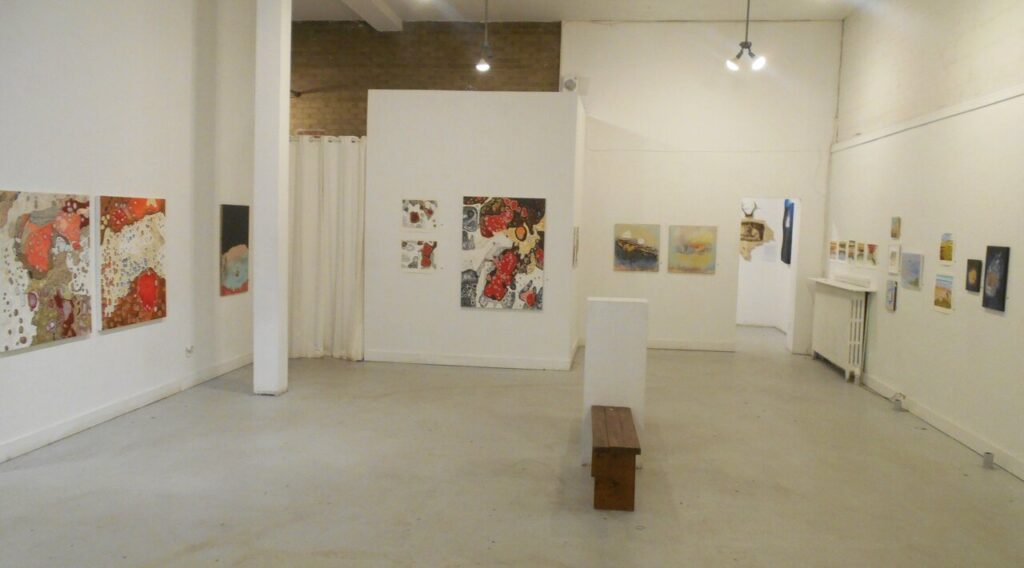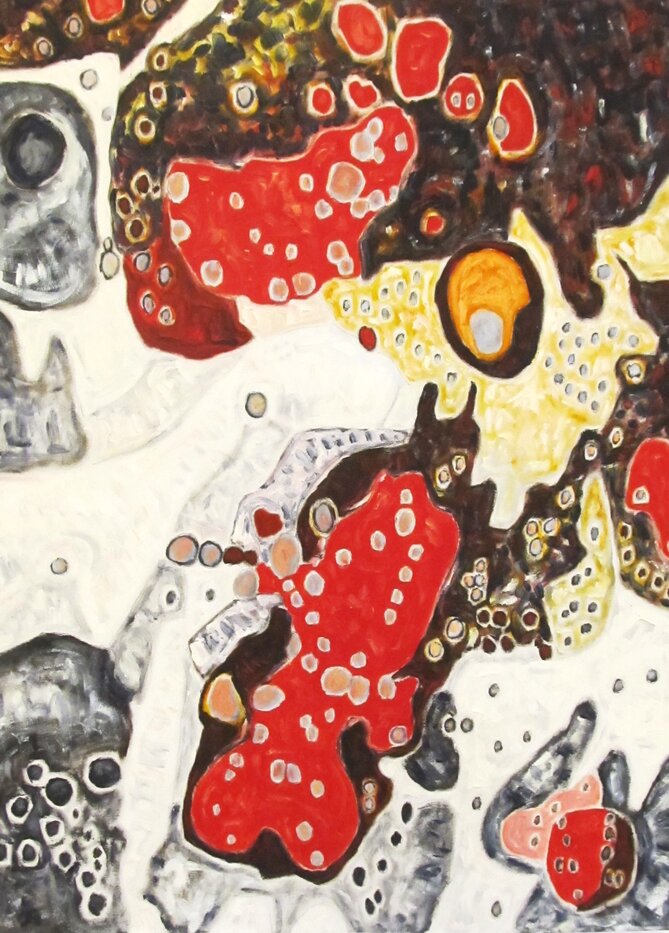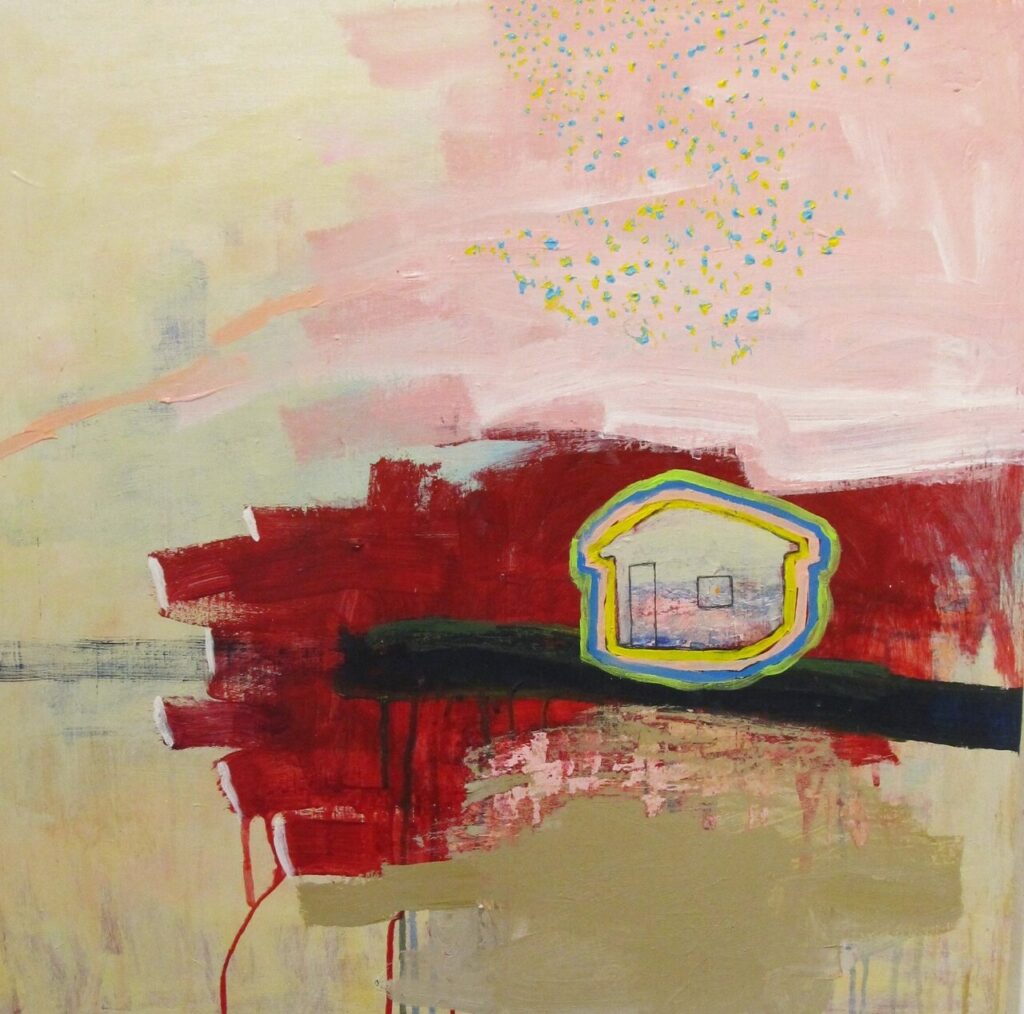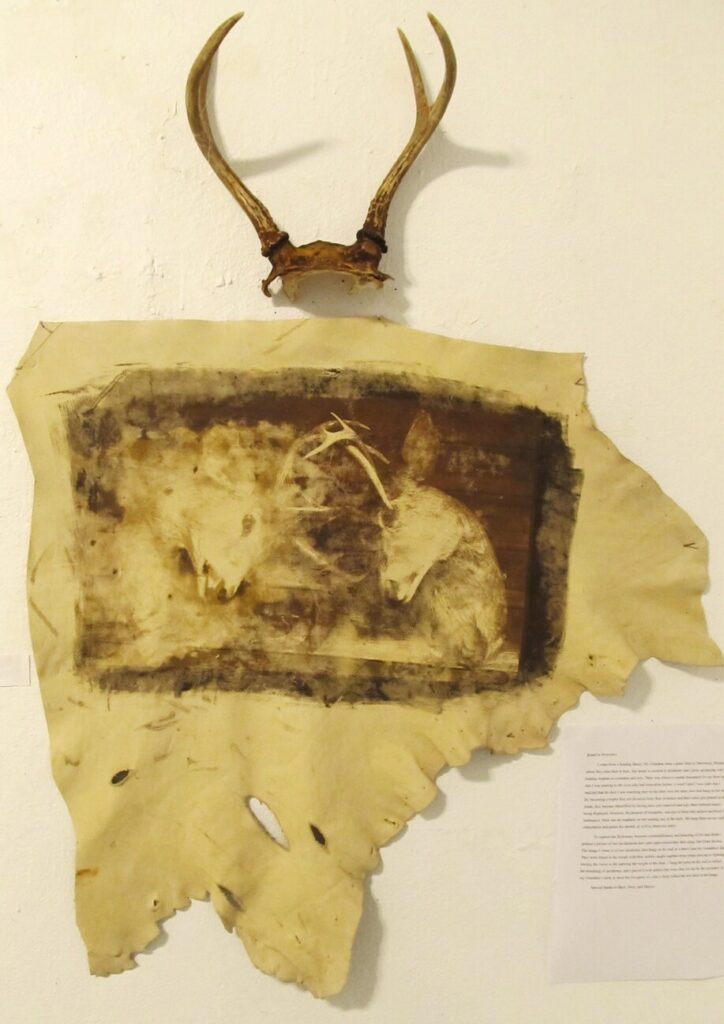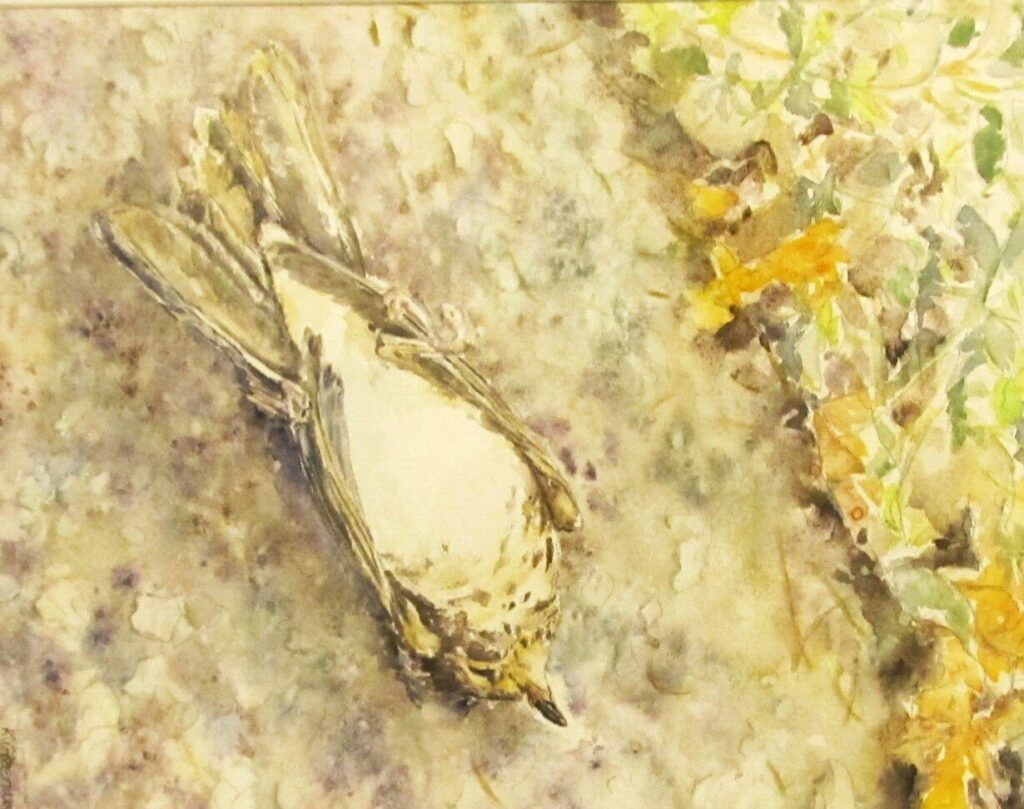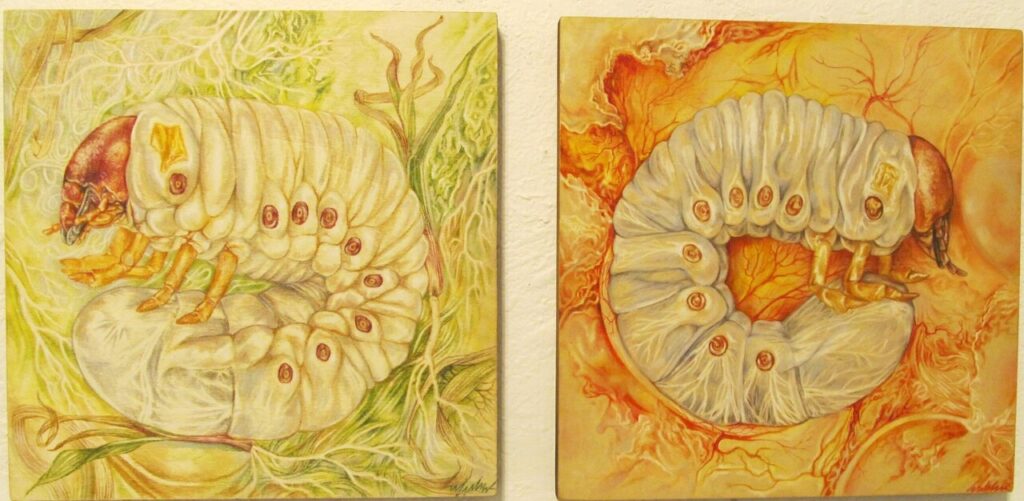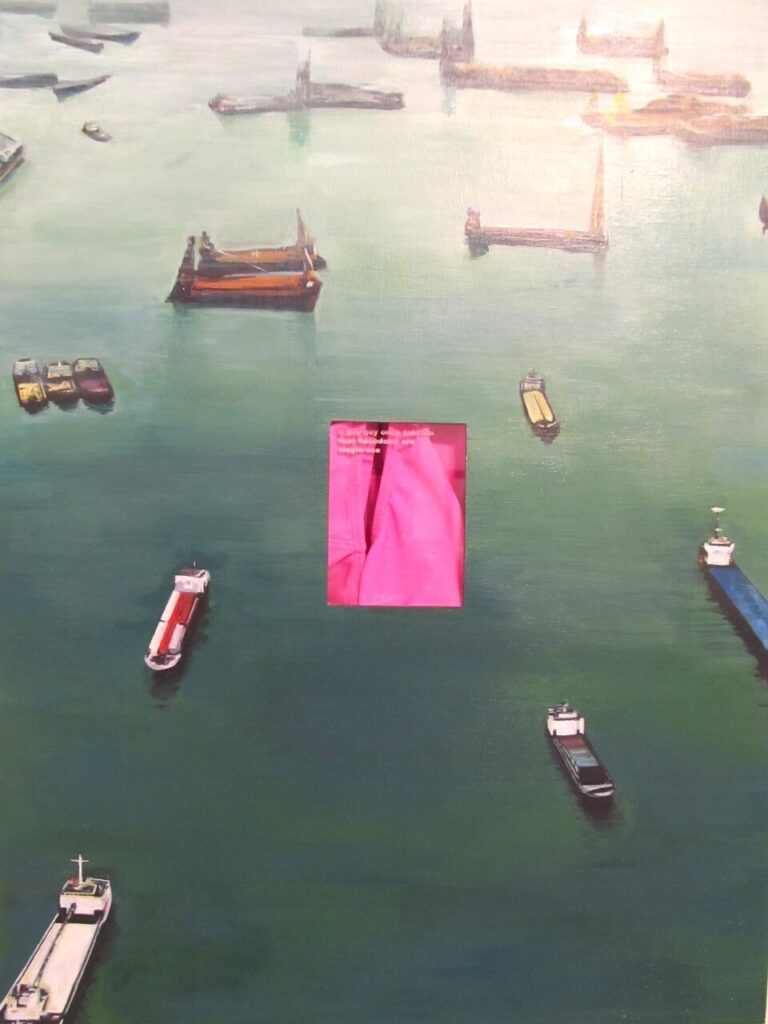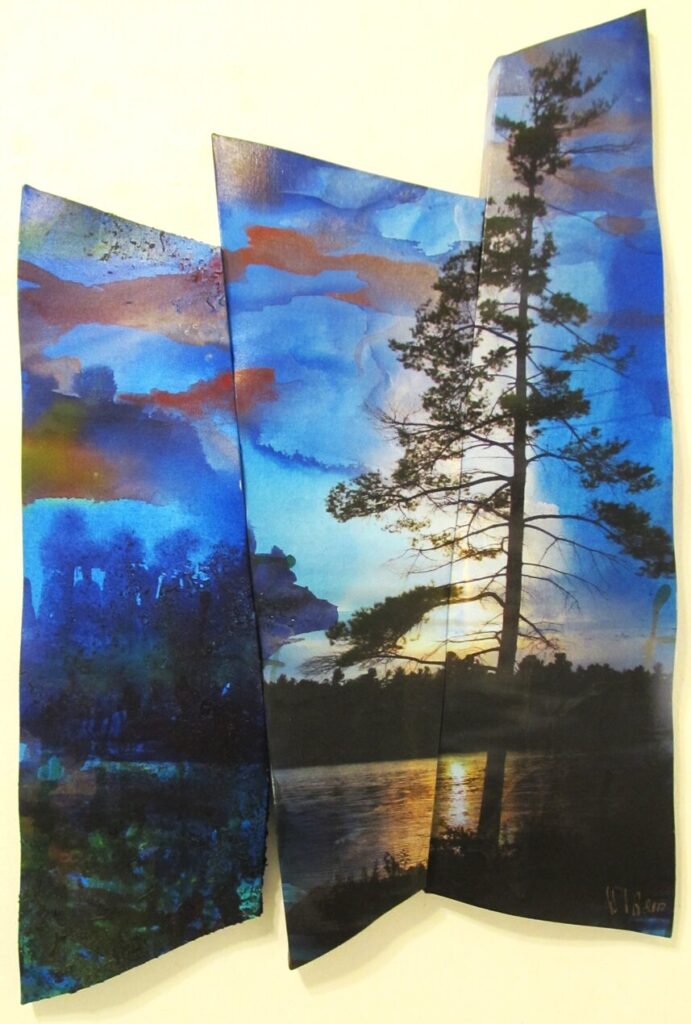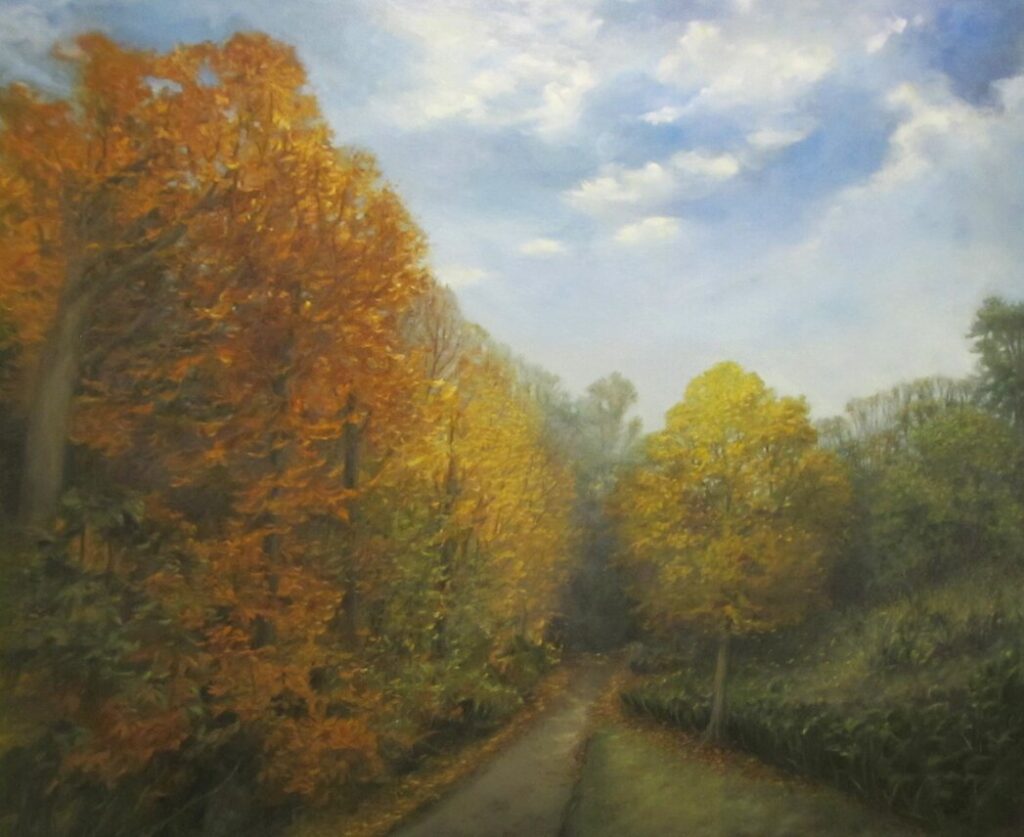Gary Blundell and Victoria Ward: Rural Living at the Main Gallery
The exhibition by Gary Blundell and Victoria Ward displays works they’ve created over the last seven years. In the show, they explore the theory “that the wilderness is a construct and that humans re-invent it every time they visit.” It involves a series of textured abstract paintings in red, orange, black and white hues and another series of ghostly dwellings in front of chaotic backgrounds. The artists are addressing the relationship between the wilderness and humans.
Installation view of Rural Living
Gary Blundell large works appear to be random and abstract compositions of animated amoebic forms. The soft curving shapes dance along the canvas and fill it with textures, colours and energy. At first sight, it reminded me of the images seen when looking into a microscope. Blundell wrote in his artist statement that he was inspired by the topography of Lake Huron. He has a lyrical relationship with the lakeshore as he depicts them through the aerial views, colours, shapes and movement. It is important to remember that we are all interconnected and form a part of a larger, older system that keeps us, our environment and our land in order.
Gary Blundell, Red Polls, 2024, oil and pencil on canvas, 48 x 30 inches
The powerful reflection evoked by Blundell’s artwork is accompanied by Victoria Ward’s pieces. They bring up themes of isolation, solitude, and abandonment. Rainbow Shack depicts a phantom-like house but there are no human figures near it. Instead, the house is surrounded by rough brushstrokes, bright colours, and a sort of aggressiveness that envelopes the small house. I understand this as a visual representation of the wild taking back what has always been rightfully its.
Victoria Ward, Rainbow Shack, 2014, acrylic on wood, 24 x 24 inches
Rural Living is a wonderfully rich and radiant exhibition and is deeply thoughtful. I found the show to be a pensive and exciting journey through the unseen rural landscapes of Ontario.
Eco Art / Group Show in the Process Gallery
The Eco Art exhibit is a group show curated by Phil Anderson that includes paintings, collages, photographs, sculptures, and more mixed media pieces. While the mediums and styles are wide-ranging, the theme manages to stay straightforward and cohesive. It is amusing to observe and appreciate how different artists take the same subject and interpret, represent, and express them in varied and creative ways.
My favourite is Bound in Reverence, a striking piece by Sophia Poland Noetzel. The artwork is composed from a set of antlers that hang from the wall, and right below them, a deer skin has an imprint of two deer fighting. I gravitated towards this work because I was intrigued; why an artwork made from animal remains would be included in a show about creating conscience and opening a conversation about environmental issues. The artist explains in her statement that coming from a hunting family and having been surrounded by taxidermy in her childhood, she developed an interesting, complex, and at times conflicting relationship to the life and death of the deer. She is seeing the taxidermized bodies as objectified beings that only gain value through death as well as a monument or memorial to honour the life lost. The conversation regarding the life and death of deer in this artwork is haunting and creates a captivating piece to include in an exhibition about environmental issues.
Sophia Poland Noetzel, Bound in Reverence, mixed media, 27 x 38 inches
Fester + Bloom by Maddie Wilmink and Ode to the Fallen by Kate Greenway pay homage to animals. They are trying to tell the viewers that “what you are expecting to see is not what is represented”. Th colours employed in Ode to the Fallen is reminiscent of landscape watercolour images, where the attractiveness of the environment is celebrated. However, Kate Greenway’s painting is more meditative and poetic, as she is paying tribute to those birds, who have fallen. Comparably, the delicateness explored in Fester + Bloom is at odds with the two larvae drawn, since larvae are usually seen as unattractive subjects. The two images are juxtaposing each other. Greenway depicts the death of a bird while Wilmink focuses on the beginning of life, as a larvae will turn into a beautiful butterfly.
Kate Greenway, Ode to the Fallen, watercolour, 13 x 26 inches
Maddie Wilmink, Fester + Bloom, mixed media, 12 x 25 inches
Neoliberal Shipping Containers by Gregory Brown is more conceptual, with a background full on shipping boats and a bright pink piece of fabric. There is a writing on it, “a gay guy once told me speedos are single use” that brings attention to the consumerism in our society that demands so much of our environment.
Gregory Brown, Neoliberal Shipping Containers, acrylic on board and speedo, 18 x 24 inches
The two works by Paul Brandejs that placed to mirror each other are sculptural, 3D paintings. They look like images from a dream or a hazy memory. Characterized by the blue hues depicting lake or forest scenes at night, these works symbolize fragmentation, while the reddish clouds suggest air-pollution. When closely inspecting them, viewers can admire the entanglement of strings of acrylic paint and other 3-D aspects, an interesting use of acrylic.
Paul Brandejs, The Lone Sentry, 2014, acrylic on shaped canvas, 39 x 34 inches
The Eco Art show is a perfect, straight-forward culmination to the environmentally conscious exhibitions that currently flood Gallery 1313. In diverse and creative ways, each artist calls attention to the wounds our environment is facing and makes it impossible to ignore the discussions that must be held regarding the current environmental precariousness.
Michelle Montague: Highlights from Memory at the Cell Gallery
Entering the room we see eight beautiful landscape paintings. The airy brushstrokes give them a flow, a movement. Looking at Autumn Sky I imagine the sound of the rustling leaves and the crisp air that whispers through the greenery. I picture birds chirping and flying over me as the sun prepares to set, and as I walk further into pathway, I notice the crunchy leaves beneath my feet. Montague captured the forest so well, reminding us that these genuine moments in nature are essential for all.
Michelle Montague, Autumn Sky, oil on canvas, 43 x 40 inches
I particularly appreciate the winter scenes like Under the Moonlight and The Stillness of Night, where the details of the landscape immerse the viewers into the chilly images: the swooshing waves, the wet sand being illuminated by the moonlight, or the naked tree branches and the footsteps imprinted into the snow.
Michelle Montague, Under the Moonlight, oil on canvas, 40 x 24 inches
Sitting among the artworks, I reflect on the importance of capturing these ephemeral moments among the ruffled trees, the green pastures, the flowing stream, and the snowy trails. I ponder on the words the artist wrote, reminding of the vitalities of nature, its rejuvenating power and the essential and intrinsic connection that exists between humankind and nature. The artist was interested in a moment of quiet contemplation, and I think she depicted it wonderfully.
Sofia Diaz Aguilar
Images are courtesy of Gallery 1313. Photo: Phil Anderson
*Exhibition information: Rural Living; Eco Art 2025 and Highlights from Memory, May 28 – June 8, 2025, Gallery 1313, 1313 Queen Street West, Toronto. Gallery hours: Wed – Sat 1 – 5 pm, Sun 1 – 4 pm.

